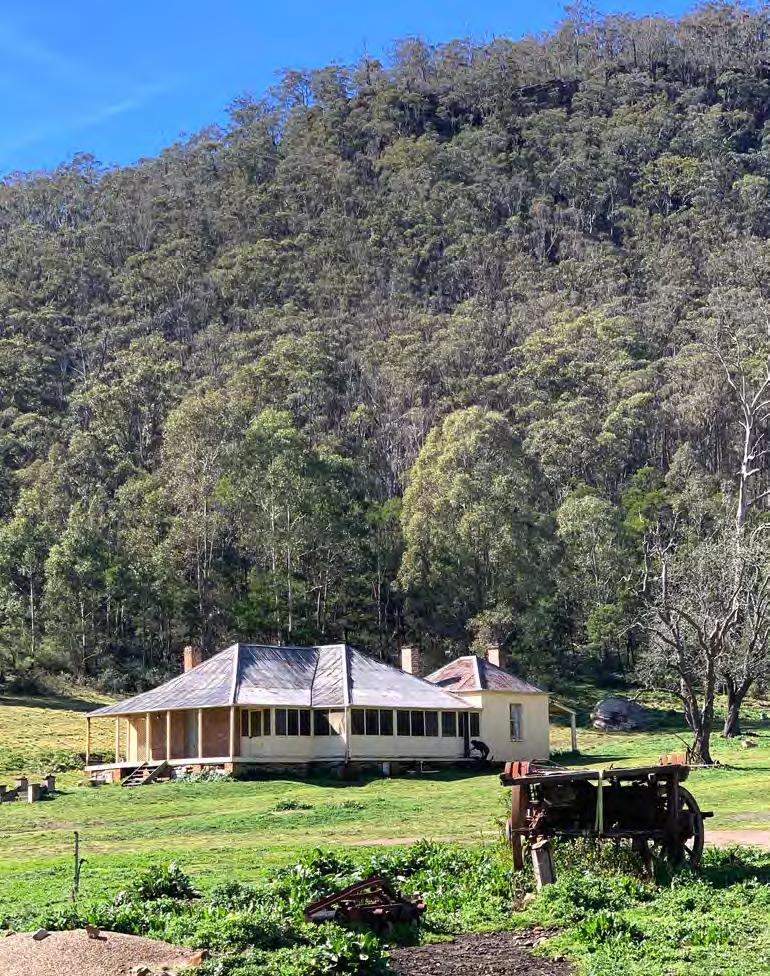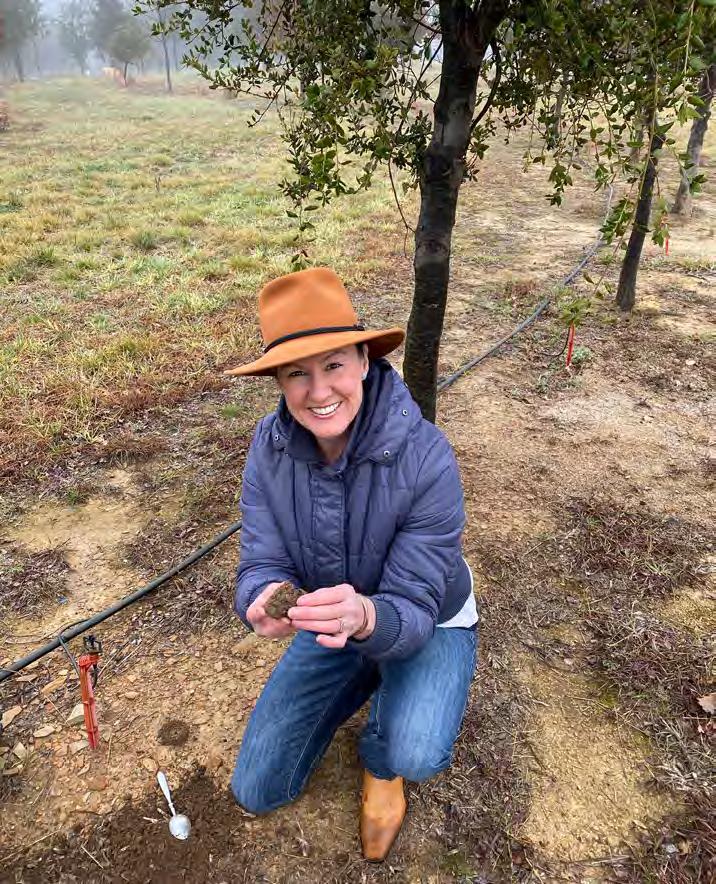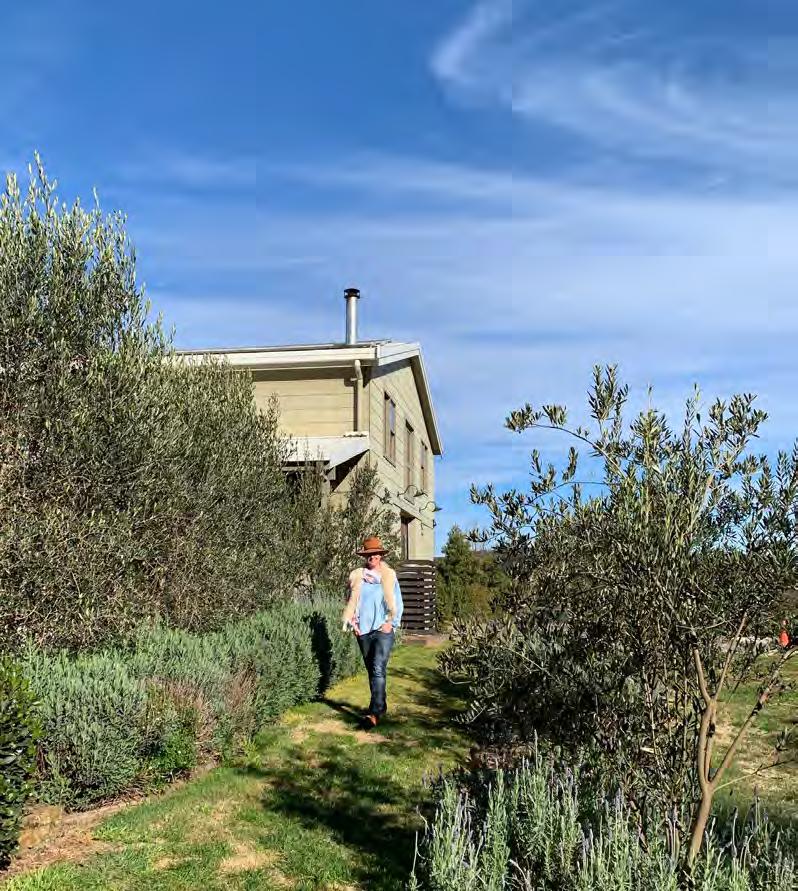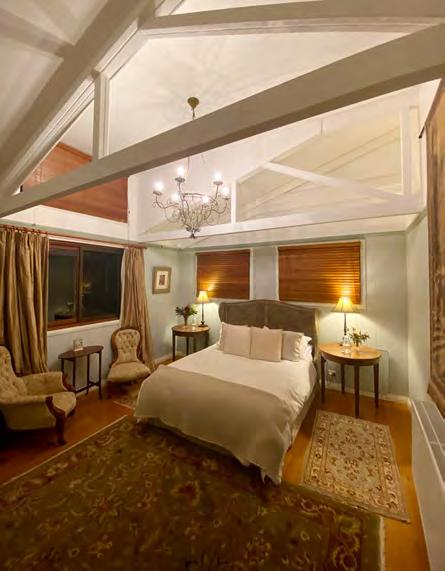
13 minute read
Rolling through the Highlands
Rolling through the Higlands
A few bonnie days in NSW’s Southern Highlands and you’ll feel as though you had a wee escape into the heart of Scotland.
Advertisement
Words: Michelle Hespe
ROMANCE AT THE ROBERTSON
Towering conifers, sprawling fig trees, neatly trimmed hedges and Weeping Willows adorned with fairy lights create film-like surrounds as we cruise up and around The Robertson Hotel’s gravelled circular drive. A statue of Mary imported from the Vatican graces the space, and a stone artist’s impression of baby Pan is resting playfully in the perfectly manicured gardens with his flute at the ready.
Smoke from the hotel’s many fireplaces rises against a star-filled sky and peals of laughter escape from the warmly lit windows of the restaurant where we’re booked in for a delightful Christmas in July feast.
We park our car and head towards the entrance of the famous hotel that has had many incarnations and numerous names since it was built in 1924 – Hotel Robertson, Hotel Ranelagh, Ranelagh Country Club, Ranelagh House and Fountaindale Grand Manor.
Bar the now-mandatory masks worn by the impeccably suited staff buzzing about, it’s as though we have stepped back into the 20s. At the manor’s entrance, water trickles from stone wine barrels upon which bare-bottomed cherubs sit like cheeky guardians, the light spilling from dormer windows adding to the dollhouse charm. Chandeliers light up the lobby’s grand hallway, where we’re welcomed and quickly ushered to our seats before an enormous fireplace with logs crackling away. Napkins are slipped across our laps and as if on cue for our arrival, a harpist seated beside a Christmas tree heavily laden with gold baubles begins to play. All voices hush to an appreciative murmur.
Three suitably UK Christmas favourites are served – pumpkin soup and steaming hot bread rolls with lashings of butter; sliced ham and turkey with baked vegetables, creamy whipped mash and a hearty slathering of gravy; and then perfectly moist Christmas pudding with a brandy sauce to round things off.
The feast wraps up with tea, coffee and a rising crescendo emanating from the kitchen – and then a Scottish marching band takes everyone by surprise as the members strut into the room with kilts firmly in place, followed by a jolly bell-ringing Santa who draws the lucky door prizes.
We sip on a lovely Tertini Pinot Noir and then like all good highland folks, retire to the moody 1920s bar area where we make ourselves comfortable on Chesterfield couches covered in velvet cushions. Soft merino blankets are on offer to spread across our knees and the staff continually stock the numerous fireplaces.

Later we wander around the hotel’s many corridors and sitting areas filled with lounges and bookshelves, display cabinets, intricately carved side boards and coffee tables – ornaments, books and lamps from yesteryear sitting like artfully scattered stories of what might have happened between these walls.
We find our suite and love its high ceilings, king-sized mahogany bed and exceptional views of the gardens and driveway below. The toilets still have the original pull-chains that I haven’t seen since I was a child.
The Robertson’s many previous owners have ensured that its original Gatsby-esque charm has been preserved. The grand entry staircase, ornate ceilings, many hanging chandeliers and the stained glass windows installed by monks are just some of the incredible details highlighting its uber luxurious past.
In fact, the hotel was named the ‘Most Luxurious Hotel in the Commonwealth’ by the media a year after opening in 1925. Back then it boasted a nine-hole golf course, two tennis courts, croquet, lawn bowls, billiards, fishing, hunting, horseback riding, and an on-site mechanic who looked after guest’s cars. And it was the first hotel in Australia to have phone lines in every of its 100 rooms. Golfers were given a whistle on a string when heading out to play, so they could be located when the famous ‘Robbo mists’ rolled in.
Alf Stephens (of Alf Stephens & Sons) was the builder of the manor. Stephens employed only the best craftsmen in the region to create the masterpiece and he was best mates with none other than Sir Donald Bradman. The two spent many a day and evening on the premises, enjoying all that the hotel had to offer.
If only the walls could talk.
And in some senses, they do. In one of the staff change rooms, the odds on
several horse races of the day are etched on to the wall – with the name Phar Lap coming up more than once.
In 1947, the building was converted into a Franciscan Friary and seminary – thus the installation of stunning stained glass windows, meticulously assembled rock walls and numerous fountains. Franciscan monks kept peacocks and many other birds and animals on the grounds, as they were known as protectors of all creatures great and small. Animals seem to be a recurring theme – the hotel was also the set for the cult classic film BABE, with many of the scenes shot in and around the buildings.
Today, Sydney hotelier Con Kotis and his wife Lisa own the hotel. After falling in love with the place in 2011, they are committed to slowly bringing the manor back to its original glory with a multi-million dollar overhaul. They have big new plans that have just been passed by council that include a new swimming pool for the locals and visitors, hot spas reminiscent of European spas, a large modern conference centre, family-friendly eco cabins, and a petting zoo. An artist’s studio will also be installed in an existing cabin in the rainforest next to the hotel, and The Robertson’s very own train station is in the process of being lovingly restored.

WHISKY LOVING AT JOADJA
We enjoy a leisurely breakfast of bacon and eggs in another of the hotel’s light-filled dining rooms and then head off down the drive.
There’s nothing quite like a crisp, blue-sky day with an early morning mist in the Southern Highlands, where most residents are devoted to maintaining their English-style gardens and enormous neatly trimmed hedges that have taken a century or more to grow.
Rolling green hills, paddocks bursting at the seams with produce, vineyards graced with sunshine and cool evening breezes and dams the size of small lakes form a constant backdrop for cruising along the winding roads that pass through quaint villages dotted with sandstone homes, cafes, churches and gift stores.
And there’s a good reason why so many of the town names and street signs have a Scottishness to them – Bundanoon, Brigadoon, Balmoral, Braemar, Glenquarry, Craigieburn, Invergowrie and Highland Glen to name a handful. Much of this Scottish influence can be traced back to Joadja Town – a now-abandoned historic settlement established in the late 1870s by the Australian Kerosene Oil and Mineral Company. By heating shale in unique D-shaped iron ‘retorts’, the company produced kerosene, candles, wax and oil between the 1870s and 1911. Hundreds of Scots were employed as shale miners and on the side – lo and behold – the stilling and brewing of sly grog began.
Today the Spanish-born Jimenez family own the property and in 2014, the Scottish heritage and history of bootlegging inspired them to set up Joadja Distillery in the heart of the valley surrounded by mountains where the mine’s crazily steep inclinator once crawled up and down.
Now visitors can partake in a whisky tour and some wee drams that were created in hand-picked ex-sherry barrels that pay homage to the owners’ homeland. It’s a truly unique experience as Joadja is one of only a handful of single malt whisky distilleries in the world to grow their own barley on site, and the property has its own natural springs. The distillery also produces fortified wine, a dry gin, anis liqueur, 100-proof rum and a delicious brandy.

Guests can take a drive through the old town and see the rows of empty shacks where once around 1,000 miners and their families lived and worked. There are also many remnants of the mine that have survived – such as brick furnaces and part of a railway.
On your way in or out of Joadja, swing into the lovely Joadja Estate – a picturesque winery where you can book a wine tasting with a cheese board. They do a lovely sparkling chardonnay pinot noir and a light and crisp summer rose. For those with a sweet tooth, don’t miss a sip or few of their boysenberry liqueur.
GOING FOR GOLD
The Southern Highlands (that expands out into the Southern Tablelands) has an abundance of food and farm experiences, but as it’s truffle season (June to August) we’ve decided to include a truffle lunch at the aptly Scottish named The Loch in our packed itinerary. And so we thought it wise to gain some fancy fungi knowledge beforehand.
Let’s face it – much like oysters, truffles are an acquired taste and many find them a little too pungent to enjoy. While others consider them to be pure culinary gold.
Wayne Haslam and his son Justin at Blue Frog Truffles in Sutton aim to de-mystify the mighty funky fungi through talks and tours of their farm, where guests can venture into the paddock with dogs and their handlers, locating and digging up truffles.

“The fungus infects the roots of the trees and lives in a symbiotic relationship with the tree, breaking down minerals in the soil, otherwise unavailable to the tree. In return the tree generously provides sugars and carbohydrates for the truffles, which are the annual fruiting body of the fungus,” Wayne explains to us. Pretty simple so far.
“A standardised testing scheme has been refined and introduced by the Truffle Growers Association in Australia, where black truffle inoculation of hazelnut and/or oak seedlings can be validated and evaluated prior to purchase by prospective growers. Before this, it was really down to being lucky if you had the right trees and conditions for truffles to grow on your land,” he says.
Wayne explains that sometimes you might find a rare truffle that has broken the ground and is poking out of the soil, but really, dogs are an essential part of locating truffles.
“They used to use pigs because you didn’t have to train them, but pigs love to eat them so you lose a lot or have to fight for them,” Wayne explains. “Believe me, there are many older European truffle farmers who fought pigs for truffles and now have a few fingers missing!”
We have a great time in the rows of almond trees, following the dogs around and getting as excited as them about their golden finds. Our dog enthusiastically taps her paw – X marks the spot – and grins from ear to ear when she receives her treats – little pieces of cabanossi. Once the truffles are marked for Wayne with a pink flag on a steel rod, off the dog trots in search of more treasure.
So that we can have a go at foraging, Wayne hands us our high-tech truffle digging equipment (a tablespoon) and after we carefully dig up our very own truffle, he wraps it in a napkin for us to take home and enjoy.
“They’re as thick as boots, just scrub it down at home,” he says warmly while waving us off.
Wayne later emails us a few basic recipes to get over our truffle cooking fear and I opt for his son Justin’s
favourite – truffle scrambled eggs with bacon on toast. You pop the eggs in a container with the truffle for a day or so and they absorb the flavour through the shell. Scramble in a frying pan and serve. You can’t get more simply gourmet than that.
FUNGI FIELD DAY AT THE LOCH
Well, actually, you can really ramp up the gourmet Richter scale in many places in this region, and our Scottishthemed gourmet getaway came to a glorious end with ‘Fungi Field Day’ at The Loch.
The gorgeous estate, which is only six kilometres from the heart of historic Berrima, hosts regular food, music and business events and is owned and run by the extremely talented business woman and chef Brigid Kennedy.
Brigid has turned what was once an old barn into one of the most sophisticated and luxurious (yet somehow understated, in a rustic Tuscan villa kind of way) places to stay in the region. Complete with sprawling gardens for al fresco dining and dancing, and a vegetable patch that would make any green thumb jealous, the place is an oasis of style.

When we arrive the garden is alive with music, laughter and the tinkling of champagne glasses filled with a sparkling red from Cherry Tree Hill winery, down the road in Sutton Forest. Soon we’re seated at our own antique wooden dining table in the middle of the lawn, with an exciting fungi-filled menu before us.
The farmer who grew the truffles – Dick Groot Obbink of Durran Durra Truffles – delivers a fascinating talk about his own experience as truffle grower, explaining the mind-boggling array of scents you can depict in any given truffle. We’re helped out with a picture of a truffle aroma wheel to refer to during the meal.

Brigid takes to the stage (aka her garden) throughout the five delectable courses to explain our meals – and as anyone will know who has eaten Brigid’s food, the perfectly balanced, truffle- and mushroom-infused dishes are just as beautiful in appearance as they are in taste.
The first entrée is tempura pink, yellow and white Li-Sun oyster mushroom topping Agedashi dofu matched with a Tertini Riesling, followed by Gruyere fondue with Durra Durran truffle shavings (that Brigid applies herself, popping from table to table like the impish dynamo she is) served with croute and baby pickles.
The mains are just as good – Wafuglazed Loch beef fillet squares on Li-Sun Shimeji harvest rice paired with a Rotherwood Estate Pinot Noir and Loch-foraged Saffron Milk Cap mushrooms preserved in salsa verde, layered with prosciutto and Fontina (Italian washed-rind cow’s milk cheese) lasagne with a pine nut salad.
Dessert is mouth-wateringly zingy – lemon curd layered with blood orange jelly on a chocolate crust with pink grapefruit and native lime drizzle. To balance things out, it’s served with Joadja Estate’s much-loved boysenberry liqueur.
As the sun slips down toward a field of horses grazing, creating a paddock-to-sky sunset of glowing orange with soft swirls of hot pink and purple ribbons, we sit in Brigid’s garden and watch as one by one, our dining friends disappear. We wave goodbye, feeling rather smug about having booked a night at The Loch in one of the four luxuriously appointed guest rooms.

Now we simply have to cross the garden, ascend the stairs and fall into our queen-sized bed in The Argyle Room, which, fittingly, has sweeping highland views fringed with pear capital trees. There’s nothing more to do on our little Scottish getaway, except climb into bed and pour ourselves a wee dram from Joadja. As the Scots would say: Slàinte Mhath!





